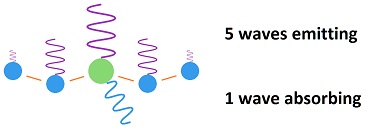|
| Gary Novak
The Cause of Ice Ages and Present Climate |
Secondary Effects Are An Impossibility The claim is that two thirds of the heating caused by global warming is due to secondary effects. Climatologists claim that the primary effect of carbon dioxide in the air is to increase the near surface temperature by Hysteresis Shows The Impossibility If there were such a secondary effect, hysteresis would occur and cause continuous increase in temperature. Hysteresis means the output influences the input causing an overwhelming increase. It would cause global warming to go to an extreme and not easily decrease again. The ability of temperatures to change easily shows that hysteresis does not occur. The counter-argument is that hysteresis does not occur, because the increase is a one-time thing. That claim is so absurd that it shows there is no counter-argument. Nothing about claimed global warming is a one-time thing. The process is a dynamic system. Dynamic systems do not consist of events but rates of change. Hysteresis would occur with a dynamic system, because any increase would influence the cause. To say otherwise is to say the temperature increase due to a greenhouse effect is not the same as a temperature increase caused by other factors. There is no difference. Temperature increases are all the same. Every increase in temperature should produce a secondary effect of causing more water to evaporate and triple the temperature, if there were such a thing as a secondary effect for greenhouse gases causing global warming. No Increase In Water Vapor Regardless of hysteresis, no increase in water vapor would result from global warming caused by greenhouse gases. The amount of water vapor in the air is determined by ocean temperatures, not air temperatures. An El Nino shows the result. When the ocean surface temperature increases during an El Nino, rainfall greatly increase in the area affected. There is no mechanism for air temperature increase to cause water vapor to increase. Water that evaporates must come from somewhere. It comes from the oceans. It cannot come from the soil, because The amount in the soil is limited and does not change. Evaporation from the soil is independent of temperature variations. Wind is the primary factor which cause water to evaporate from the soil, and it rapidly reduces the amount of water available, until precipitation adds more. Change in air temperature is irrelevant to the process. It is scientific incompetence to assume air temperature determines the amount of water vapor in the air. The assumption seems to be that warm air holds more water vapor so it will have more water vapor. There is no scientific concept or mechanism for holding capacity determining the amount of water vapor in the air. Warmer and dryer air will absorb moisture slightly more rapidly, but the speed is never relevant. Plenty of time always exists for air to do whatever it is going to do. The assumption is as if increased air temperature would draw more water vapor from the soil. Availability of water in the soil is the limiting factor, not the temperature. If some water vaporized sooner, there would be less vaporized later, so the net amount of vapor does not change significantly. When precipitation adds more water to the soil, the origin is the oceans. Sure, weathermen notice a follow-through, where previous precipitation encourages new precipitation, but the effect is nothing more than recycling the water that originates with the oceans. Ocean temperatures cannot be changed by the claimed greenhouse effect, as mathematics show here: Hurricane Math—because there is not enough heat capacity in the air to influence ocean temperatures. Therefore, the amount of water vapor in the air cannot be increased by the oceans upon a supposed global warming. In other words, weather is controlled by the oceans, not the air temperature.
Air over the oceans becomes the same temperature as the ocean surface. If the average air temperature increased by a small amount, it would not change the temperature of the air in contact with the surface of the ocean. Climatologists claim warmer air will acquire more absolute humidity due to its increase in holding capacity. But the temperature of the air over the oceans will equilibrate at ocean temperature. No temperature change occurs where water vapor is entering the air—at the surface of the oceans. There is no significant increase in holding capacity while in contact with the surface of the oceans. Holding capacity of air over the land is not relevant, because the amount of water available over land is the limiting factor. So increase in holding capacity is an erroneous and irrelevant concept. Again, if the increase in holding capacity were creating a compounded effect upon a 1°C air temperature increase, huge effects would be occurring due to the normal changes in temperature, which are typically 15°C between night and day or between seasons. Oceans heat up in a slow and continuous manner between ice ages, because the sun's energy penetrates to 10 meters causing heat to accumulate. Only ice thawing after an ice age allows the oceans to cool back down. (Radiation absorbed by the oceans creates the "coal-plant effect," because water is a coal-plant liquid.) The Primary Effect Is Also An Impossibility Heat cannot be trapped in the atmosphere, because it is re-emitted in 83 femto seconds. |
|||||||||||||||


 Secondary effects are an impossibility.
Secondary effects are an impossibility.
